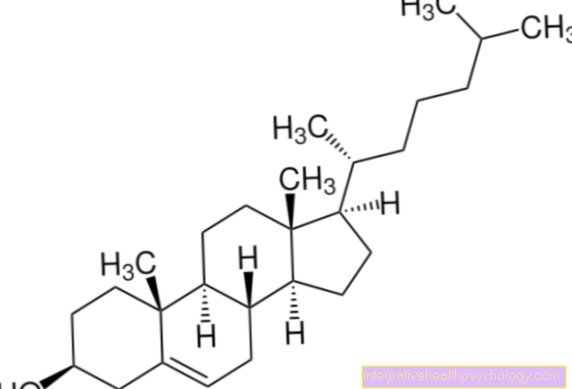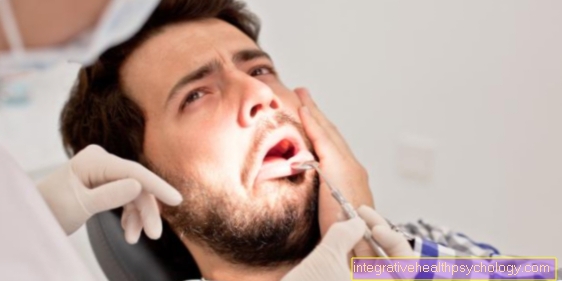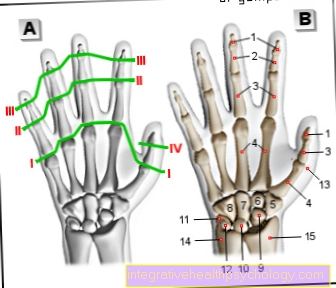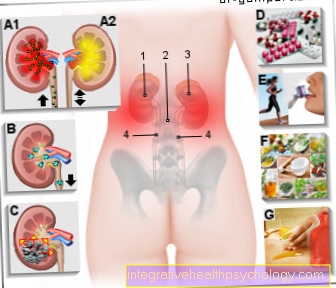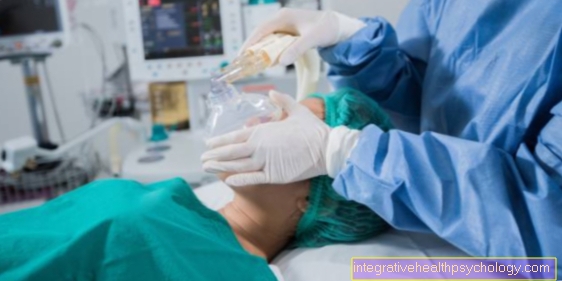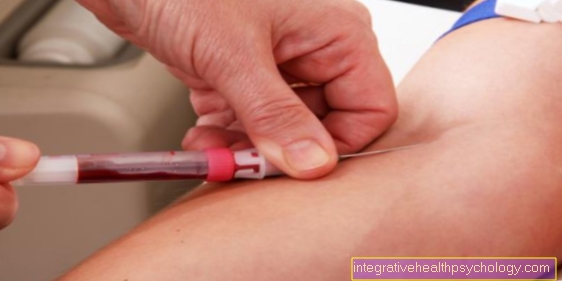Phlegmon
introduction
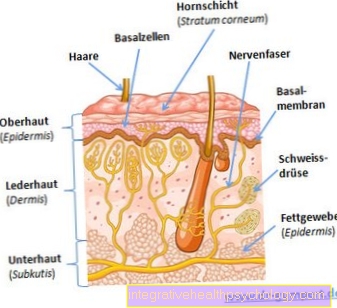
Phlegmon is a disease of the soft tissue (fat, skin ...) in which there is diffuse suppuration and inflammation. This causes the skin and the underlying fatty and connective tissue to discolor red and also become painful and purulent. The cause of phlegmon is an inflammation with bacteria.
Causes of Phlegmon
Phlegmon are caused by bacteria. In most cases, the bacteria are the pathogens beta-hemolytic streptococci, or less often around Staphylococci of type Staphylococcus aureus.
In very rare cases, however, it can also be that other bacteria cause the phlegmon, for example the group of so-called anaerobes.
These are different bacteria that only grow without oxygen (an-aerobic) can survive and therefore stay in the intestines, for example, where they are not exposed to oxygen that could damage them.
Occasionally, so-called mixed infections occur, in which different bacteria are responsible for the development of phlegmon. The reason why phlegmon can develop in the first place is usually due to a small injury to the skin and the underlying tissue.
Here it happens that pathogens that are actually on the skin (Cutis) and normally cannot overcome them because the skin represents a protective barrier, through the cut or wound into the depths of the skin (SubcutisIn some cases, even a prick with a small needle can cause the bacteria to spread deep into the tissue and cause phlegmon there.
Furthermore, it is possible that after a dental (dental) Treatment suddenly notice pain and redness in the area of the jaw.
Manipulation of the oral cavity during the dental treatment can lead to the fact that bacteria can penetrate through the opened gums into the depths of the tissue, which then leads to the formation of a phlegmon.
It is important to remember that the cause does not always have to be an externally inflicted injury, but also an injury caused unintentionally by the doctor (iatrogenic) Injury can lead to phlegmon.
diagnosis
As soon as a phlegmon advanced a doctor will recognize it already by eye diagnosis because the Skin reddened is and the injury or the Entrance portal of the bacteria ulcerated is. Often you can already first black changes in the skin recognize. This is dead tissue, so-called Necrosis.
It often happens that the phlegmon Spread quickly within a very short time so too Muscles or large areas of tissue are affected are.
In addition, the doctor can tell the patient take a blood sample there here Increased signs of inflammation are (including that C-reactive protein, short CRP as well as the Erythrocyte Sedimentation Rate, short ESR).
Because the phlegmon mostly treated surgically may need to be added a smear from the wound secretion to be taken around the diagnose the exact type of causative bacteria.
Symptoms of phlegmon
With a phlegmon there are different symptoms, which, depending on the severity of the inflammation, can appear only slightly or more intensely. However, there is always a reddening of the affected part of the body, which is also accompanied by overheating. Furthermore, there is severe pain and fever. If the phlegmon is visible from the outside, the patient will also recognize pus melt-in and black-discolored areas after a very short time. At this stage at the latest, it is extremely important to consult a doctor, as the black discolored areas are dead tissue (necrosis), which in the worst case can lead to blood poisoning in the patient (sepsis) gets.
On the other hand, some patients complain of a general lack of drive, a feeling of weakness and only occasional pain. Especially in the case of phlegmon, which arose after dental treatment, it is typical that these are not visible and only cause mild symptoms at the beginning. However, swelling often occurs in the area of the jaw. In addition, phlegmons, regardless of where they are located, are usually associated with a body temperature above 39 ° C (fever). Since it is an inflammation that spreads diffusely, the lymph nodes near the phlegmon are usually also swollen. In general, however, a phlegmon can be recognized very well by its external appearance. There is severe swelling around the wound area, in addition to widespread reddening and accumulation of pus around the wound. Black discolored necroses usually appear in later stages. It is also characteristic that phlegmon are painful and generally affect the patient very much.
therapy
Phlegmon are absolutely in need of therapy and should cannot be ignored since it is through the diffuse inflammation it can happen that the inflammation aalso spread to the blood and here one Blood poisoning (sepsis) triggers. Since the blood can circulate freely throughout the body, it can in the worst case come to the fact that the Inflammation spread throughout the body via the blood becomes and therefore it too one or more organ failure can come. However, this scenario can be used avoid with adequate therapy.
Therapy can only in the hospital respectively. For one is one high-dose antibiotic therapy necessary, which absolutely into the vein (intravenous) should be given there only one prevents systematic spread of inflammation can be. Which antibiotic is given depends entirely on the pathogen causing the phlegmon. Furthermore, it is necessary to have a Wound rehabilitation (Debridement). Here is the necrotizing and suppurating tissue over a large area in a small surgery removed so that the Do not spread inflammation further can and the dead tissue, which cannot regenerate, does not stand in the way of the regeneration of the new tissue. During the operation, the wound again and again flushed through and it can with large-scale phlegmon, additionally a Tube placed in the wound be who that Wound secretions and pus drains away. One calls this principle with the tubewho with a Collecting container is connected too Wound drainage. After the operation it is very important that affected tissues again and again easy to clean. It means that the bandage is renewed every day should be and also the Wound cleaned with the help of antiseptics must become. Since these hygiene standards and especially the therapy can only be carried out by a doctor and the treating nursing staff, is a Stay in hospital with a phlegmon indispensable.
forecast
When the patient goes to the hospital on time around there one adequate therapy phlegmon usually have one very good prognosis. Is a phlegmon, however advanced and if the patient does not go to the hospital early enough, the Inflammation progressed so far is that in the worst caseif, for example, a finger is affected, this one amputated must become. Nevertheless, it can generally be said that phlegmon, if they are treated properly, no dramatischey disease must be. Without the right therapy it can, however very quickly to with under great complications come which especially in immunocompromised patients (Children, the elderly, AIDS patients, pregnant women ...) can occur faster and therefore be taken very seriously should.







